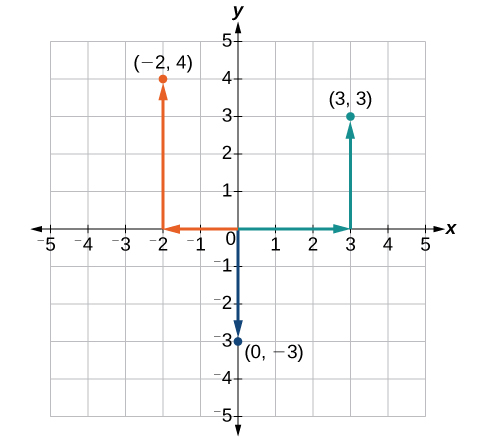Learning Outcomes
- Define the components of the Cartesian coordinate system.
- Plot points on the Cartesian coordinate plane.
- Use the distance formula to find the distance between two points in the plane.
- Use the midpoint formula to find the midpoint between two points.
An old story describes how seventeenth-century philosopher/mathematician René Descartes invented the system that has become the foundation of algebra while sick in bed. According to the story, Descartes was staring at a fly crawling on the ceiling when he realized that he could describe the fly’s location in relation to the perpendicular lines formed by the adjacent walls of his room. He viewed the perpendicular lines as horizontal and vertical axes. Further, by dividing each axis into equal unit lengths, Descartes saw that it was possible to locate any object in a two-dimensional plane using just two numbers—the displacement from the horizontal axis and the displacement from the vertical axis.
While there is evidence that ideas similar to Descartes’ grid system existed centuries earlier, it was Descartes who introduced the components that comprise the Cartesian coordinate system, a grid system having perpendicular axes. Descartes named the horizontal axis the x-axis and the vertical axis the y-axis.
The Cartesian coordinate system, also called the rectangular coordinate system, is based on a two-dimensional plane consisting of the x-axis and the y-axis. Perpendicular to each other, the axes divide the plane into four sections. Each section is called a quadrant; the quadrants are numbered counterclockwise as shown in the figure below.
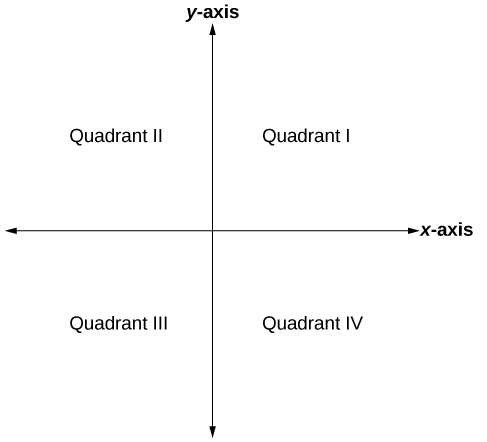
The Cartesian coordinate system with all four quadrants labeled.
Try It
The center of the plane is the point at which the two axes cross. It is known as the origin or point [latex]\left(0,0\right)[/latex]. From the origin, each axis is further divided into equal units: increasing, positive numbers to the right on the x-axis and up the y-axis; decreasing, negative numbers to the left on the x-axis and down the y-axis. The axes extend to positive and negative infinity as shown by the arrowheads in the figure below.
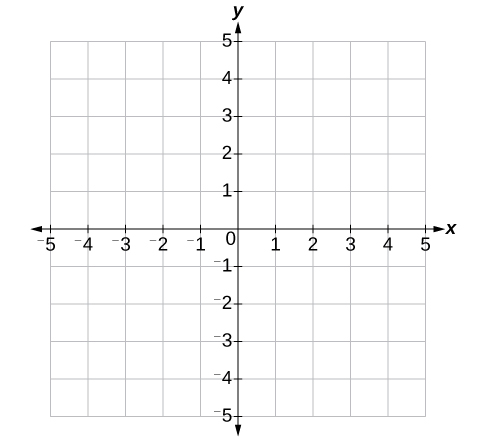
Each point in the plane is identified by its x-coordinate, or horizontal displacement from the origin, and its y-coordinate, or vertical displacement from the origin. Together we write them as an ordered pair indicating the combined distance from the origin in the form [latex]\left(x,y\right)[/latex]. An ordered pair is also known as a coordinate pair because it consists of x and y-coordinates. For example, we can represent the point [latex]\left(3,-1\right)[/latex] in the plane by moving three units to the right of the origin in the horizontal direction and one unit down in the vertical direction.
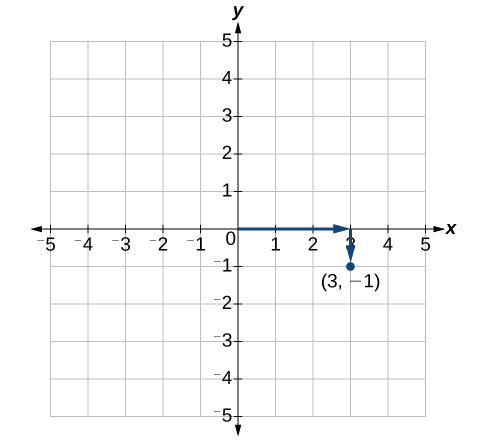
An illustration of how to plot the point (3,-1).
When dividing the axes into equally spaced increments, note that the x-axis may be considered separately from the y-axis. In other words, while the x-axis may be divided and labeled according to consecutive integers, the y-axis may be divided and labeled by increments of 2 or 10 or 100. In fact, the axes may represent other units such as years against the balance in a savings account or quantity against cost. Consider the rectangular coordinate system primarily as a method for showing the relationship between two quantities.
A General Note: Cartesian Coordinate System
A two-dimensional plane where the
- x-axis is the horizontal axis
- y-axis is the vertical axis
A point in the plane is defined as an ordered pair, [latex]\left(x,y\right)[/latex], such that x is determined by its horizontal distance from the origin and y is determined by its vertical distance from the origin.
Example: Plotting Points in a Rectangular Coordinate System
Plot the points [latex]\left(-2,4\right)[/latex], [latex]\left(3,3\right)[/latex], and [latex]\left(0,-3\right)[/latex] in the coordinate plane.
Try It
The Distance Formula
Derived from the Pythagorean Theorem, the distance formula is used to find the distance between two points in the plane. The Pythagorean Theorem, [latex]{a}^{2}+{b}^{2}={c}^{2}[/latex], is based on a right triangle where a and b are the lengths of the legs adjacent to the right angle, and c is the length of the hypotenuse.
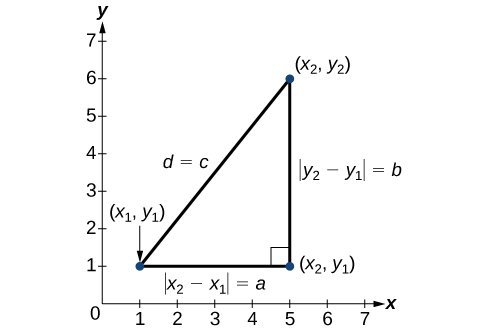
The relationship of sides [latex]|{x}_{2}-{x}_{1}|[/latex] and [latex]|{y}_{2}-{y}_{1}|[/latex] to side d is the same as that of sides a and b to side c. We use the absolute value symbol to indicate that the length is a positive number because the absolute value of any number is positive. (For example, [latex]|-3|=3[/latex]. ) The symbols [latex]|{x}_{2}-{x}_{1}|[/latex] and [latex]|{y}_{2}-{y}_{1}|[/latex] indicate that the lengths of the sides of the triangle are positive. To find the length c, take the square root of both sides of the Pythagorean Theorem.
It follows that the distance formula is given as
We do not have to use the absolute value symbols in this definition because any number squared is positive.
A General Note: The Distance Formula
Given endpoints [latex]\left({x}_{1},{y}_{1}\right)[/latex] and [latex]\left({x}_{2},{y}_{2}\right)[/latex], the distance between two points is given by
Example: Finding the Distance between Two Points
Find the distance between the points [latex]\left(-3,-1\right)[/latex] and [latex]\left(2,3\right)[/latex].
Try It
In the following video, we present more worked examples of how to use the distance formula to find the distance between two points in the coordinate plane.
Example: Finding the Distance between Two Locations
Let’s return to the situation introduced at the beginning of this section.
Tracie set out from Elmhurst, IL to go to Franklin Park. On the way, she made a few stops to do errands. Each stop is indicated by a red dot. Find the total distance that Tracie traveled. Compare this with the distance between her starting and final positions.
Using the Midpoint Formula
When the endpoints of a line segment are known, we can find the point midway between them. This point is known as the midpoint and the formula is known as the midpoint formula. Given the endpoints of a line segment, [latex]\left({x}_{1},{y}_{1}\right)[/latex] and [latex]\left({x}_{2},{y}_{2}\right)[/latex], the midpoint formula states how to find the coordinates of the midpoint [latex]M[/latex].
A graphical view of a midpoint is shown below. Notice that the line segments on either side of the midpoint are congruent.
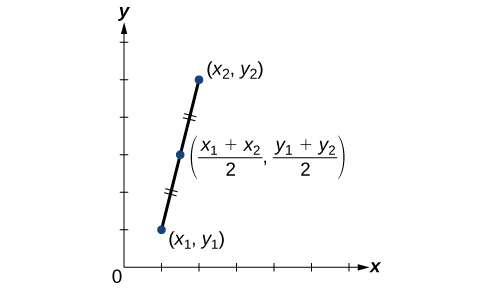
Example: Finding the Midpoint of the Line Segment
Find the midpoint of the line segment with the endpoints [latex]\left(7,-2\right)[/latex] and [latex]\left(9,5\right)[/latex].
Try It
Find the midpoint of the line segment with endpoints [latex]\left(-2,-1\right)[/latex] and [latex]\left(-8,6\right)[/latex].
Try It
Try It
Section 1.1 Homework Exercises
For each of the following exercises, find the distance between the two points. Simplify your answers, and write the exact answer in simplest radical form for irrational answers.
1. [latex](-4,1)[/latex] and [latex](3,-4)[/latex]
2. [latex](2,-5)[/latex] and [latex](7,4)[/latex]
3. [latex](5,0)[/latex] and [latex](5,6)[/latex]
4. [latex](-4,3)[/latex] and [latex](10,3)[/latex]
5. Find the distance between the two points given your calculator, and round your answer to the nearest hundredth. [latex](19,12)[/latex] and [latex](41,71)[/latex]
For each of the following exercises, find the coordinates of the midpoint of the line segment that joins the two given points.
6. [latex](-5,6)[/latex] and [latex](4,2)[/latex]
7. [latex](-1,1)[/latex] and [latex](7,-4)[/latex]
8. [latex](-5,-3)[/latex] and [latex](-2,-8)[/latex]
9. [latex](0,7)[/latex] and [latex](4,-9)[/latex]
10. [latex](-43,17)[/latex] and [latex](23,-34)[/latex]
For each of the following exercises, identify the information requested.
11. What are the coordinates of the origin?
12. If a point is located on the y-axis, what is the x-coordinate?
13. If a point is located on the x-axis, what is the y-coordinate?
For each of the following exercises, plot the three points on the same coordinate plane. State whether the three points you plotted appear to be collinear (on the same line).
14. [latex](4,1),(-2,3),(5,0)[/latex]
15. [latex](-1,2),(0,4),(2,1)[/latex]
16. [latex](-3,0),(-3,4),(-3,-3)[/latex]
17. Name the coordinates of the points graphed below.

18. Name the quadrant in which the following points would be located. If the point is on an axis, name the axis.
a. [latex](-3,4)[/latex] b. [latex](-5,0)[/latex] c. [latex](1,-4)[/latex] d. [latex](-2,7)[/latex] e. [latex](0,-3)[/latex]
For questions 19 – 23, use the graph in the figure below.

19. Find the distance between the two endpoints using the distance formula. Round to three decimal places.
20. Find the coordinates of the midpoint of the line segment connecting the two points.
21. Find the distance that [latex](-3,4)[/latex] is from the origin.
22. Find the distance that [latex](5,2)[/latex] is from the origin. Round to three decimal places.
23. Which point is closer to the origin?
24. A man drove 10 mi directly east from his home, made a left turn at an intersection, and then traveled 5 mi north to his place of work. If a road was made directly from his home to his place of work, what would its distance be to the nearest tenth of a mile?
25. If the road was made in the previous exercise, how much shorter would the man’s one way trip be everyday?
26 Given these four points [latex]A=(1,3),\text{ }B=(-3,5),\text{ }C=(4,7),\text{ }D=(5,-4)[/latex], find the coordinates of the midpoint of line segments [latex]\overline{AB}[/latex] and [latex]\overline{CD}[/latex].
27. After finding the two midpoints in the previous exercise, find the distance between the two midpoints to the nearest thousandth.
28. The coordinates on a map for San Francisco are [latex](53,17)[/latex] and those for Sacramento are [latex](123,78)[/latex]. Note that the coordinates represent miles. Find the distance between the cities to the nearest mile.
29. If San Jose’s coordinates are [latex](76,-12)[/latex], where the coordinates represent miles, find the distance between San Jose and San Francisco to the nearest mile.
30. A small craft in Lake Ontario sends out a distress signal. The coordinates of the boat in trouble were [latex](49,64)[/latex]. One rescue boat is at the coordinates [latex](60,82)[/latex] and a second Coast Guard craft is at coordinates [latex](58,47)[/latex]. Assuming both rescue craft travel at the same rate, which one would get to the distressed boat the fastest?
